Acer Aspire S5 Ultrabook Review: The Steady March of Progress
by Dustin Sklavos on July 9, 2012 7:40 PM ESTBattery Life
Acer's Aspire S5 just doesn't have enough space inside for Acer to load up on battery capacity the way HP did with their Folio 13. Acer only rates it for 6.5 hours of running time. That being said, it performed remarkably well given its battery capacity:
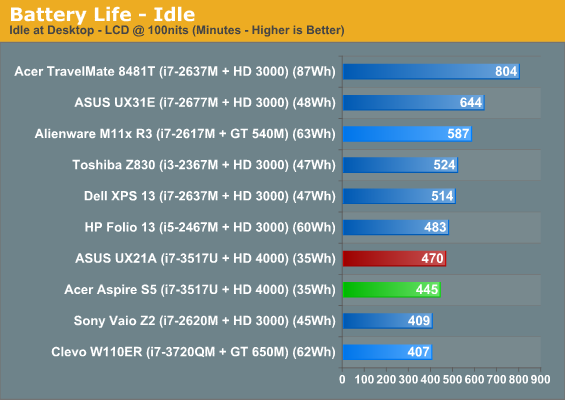
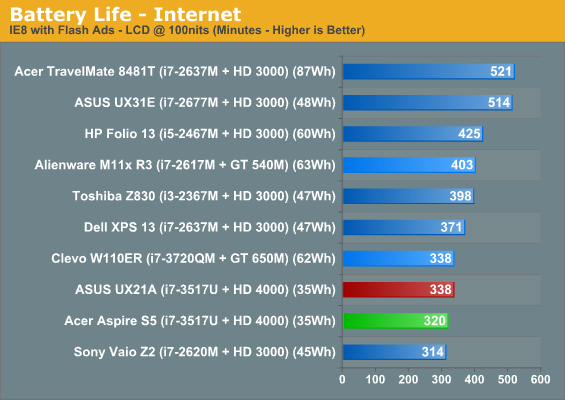
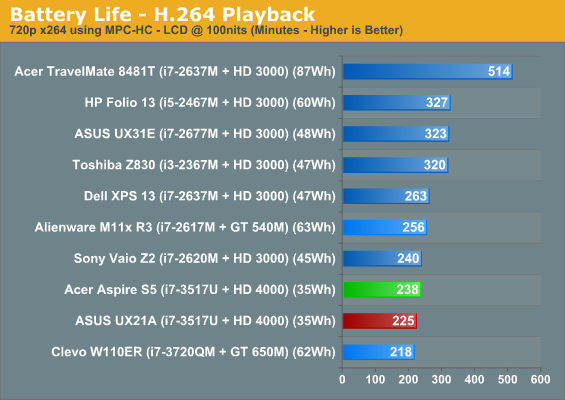
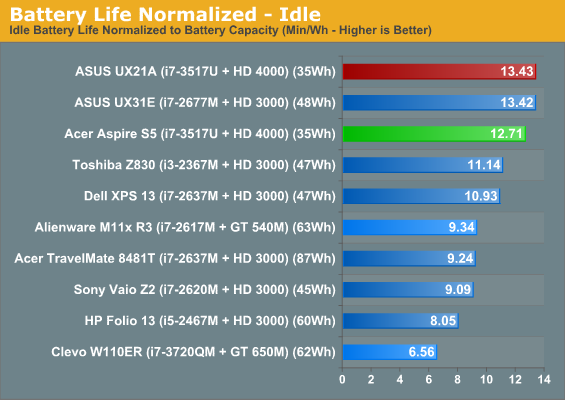

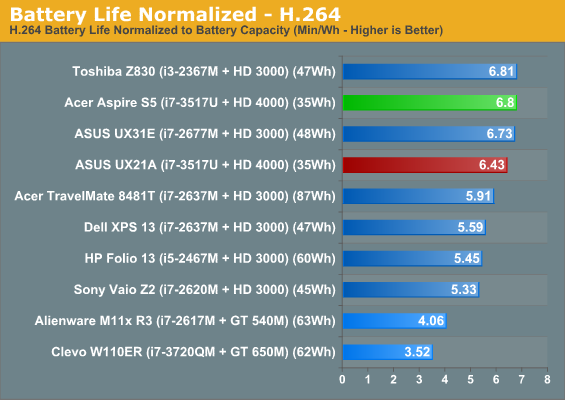
As it turns out, Acer's battery life estimate is mostly on the money and in fact can even be beaten in the right circumstances. Despite having a relatively small capacity, the Aspire S5 is still able to run for more than six useful hours. It's worth noting that overall, Ivy Bridge does seem to be able to produce better battery life efficiency as a whole than Sandy Bridge, and that's the kind of progress we can all appreciate.
Noise and Heat
Like most ultrabooks, the Acer Aspire S5 can get a bit noisy at load. What's important to note, though, is that at idle and low load, the fan is basically silent. The pitch of the fan noise is also relatively low; there's definitely the sound of air moving, but the noise is relatively tolerable compared to how high pitched these small fans can often get.

These thermals might look a little toasty, but they're actually among the best I've yet seen in an ultrabook. Acer has successfully implemented a remarkably efficient cooling system, and best of all, they've been able to do so without introducing any ventilation to the bottom of the notebook. Well done.
Screen Quality
Unfortunately, while the Aspire S5 is so far a pretty solid proposition from Acer, it falls flat on its face when it comes to display quality. The glossy finish on the S5 isn't as aggressive as I'm used to seeing, but that's about the nicest thing I can say about it. It's extremely disappointing that Acer isn't willing to bring the display up to par with the rest of the notebook.
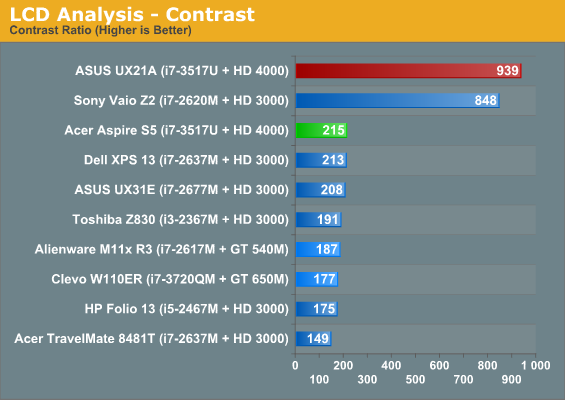


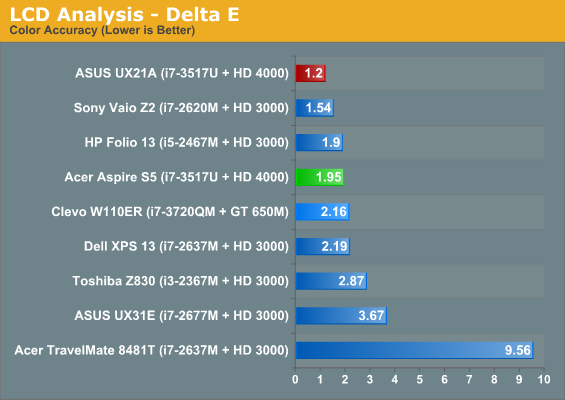
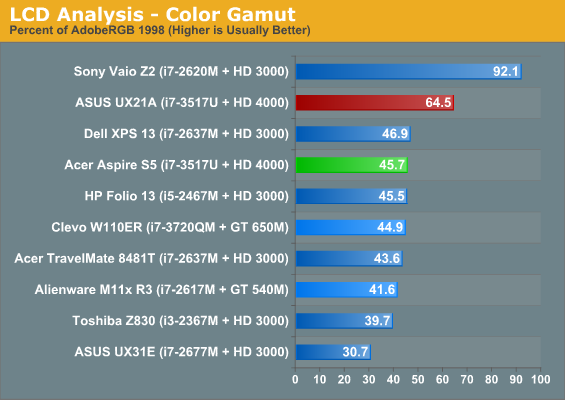

Display quality on most of these ultrabooks is just absolutely dire. If you look at the results of the ASUS Zenbook Prime UX21A, you can get a good idea of where the future lies, and it's not with shoddy panels like this one. Charging $1,399 for an ultrabook with this low quality of a panel is embarassing.










82 Comments
View All Comments
mrdude - Wednesday, July 11, 2012 - link
But how would an Ultrabook make as much sense as a 3.2lb laptop in that that scenario? There isn't even a weight restriction on Ultrabooks and as such you get Ultrabooks at over 4lbs... The portability factor only weighs in (badum-tshh) if you actually have a weight limit along with the slim design.It's also not targeted for a specific market. On the contrary. Intel believes Ultrabooks to be the Second Coming and they're pushing them as such. I disagree with you on the appeal of Ultrabooks for that "certain market." Not that there isn't a certain market, there is, it's just that that market is more interested in how a laptop looks rather than the hardware, design and practicality aspect of it. It's the reason there was a backlash from Ultrabook manufacturers when Intel attempted to push their new plastic designs. It has almost everything to do with the look and exterior of the thing and its purpose as a laptop is completely lost.
Do not want.
Penti - Thursday, July 12, 2012 - link
Consumer ultraportables are certainly something new that only came in the last 5-6 years, consumer and not professional more expensive options where the cpu could cost more then the lower end laptops. Just look at the first MacBook Air for 1600 dollars, I'd rather have ultrabook "cpus" then the traditional ULV model. Don't listen the the haters and trolls here. It's certainly a good thing for the consumers that there actually is semi decent laptops in the 800-1200 range that isn't just a heap of plastic or some business model that won't really be sold to average people. It's also a good thing to get down the number of skus and create products where you have to be more responsible, so you don't continue to deliver flawed products. For consumer wanting something more then a 500 dollar laptop and something for less than a 2500 dollar ultraportables of the old age it obviously need to be something there.While I'm disappointed at the Acer, and haven't seen them make a significant shift in tactics yet I don't blame Ultrabooks or Intel for it. It might not be for everyone but there are some good options out there, this one might not be one when it comes to storage, RAM, and screen but it does have Thunderbolt and thus DisplayPort which is another feature lacking on most Ultrabooks, and it makes it possible to use the Thunderbolt to dock into something like the Belkin Thunderbolt Express dock in September when all the Thunderbolt devices have been certified and released. It might be a little more expensive then a dock for a dockable business laptop on the other hand, but it is at least an option. If Acer wish to shift up their game I would suggest to them that they release proper business products too though not just consumer ones, that way they do actually get to sell more then their basic desktops to businesses and notebooks are today the number one client platform. They have nothing to compete with against Lenovo ThinkPads, HP, Dell, Fujitsu business lineup and so on. They have their TravelMate but it doesn't quite cut it.
For those that want stuff like discrete gpu it's starting to come some options there for consumers and they are not ultrabooks or the traditional Clevo notebooks, as some of the OEMs seem to start care a bit more about their image and market. Some professional users might still go for some nVidia Quadro solution though but a lot of the professional software starts to get support even for integrated Intel-graphics.
It also really depends on what kind of device it is, now the iPad 3 gen has a larger battery then the 11-inch MBAir.
For Intel it makes sense to sell something lower power to the sub 1500 and sub 2000 dollar market, nothing wrong with that. The Ultrabook cpus are pretty full feature and a lot faster then the old CULV lineup. They do often lack stuff like vPro and trusted excution though but for manufacturers there are options of using 17W cpus with those features too. VT-x, VT-d, turbo boost, hyperthreading etc is all there on all ultrabook models. There are some design considerations to make that you have to do if you go from a 17W TDP CPU to a 35W TDP cpu that costs the same amount of money. And only offer higher clock speeds. Something like i7-3667U should be plenty fast even as a small workstation and business machine. So I'm not quite sure why you would turn to 35W TDP cpus here per default, there are some good and balanced i5 IVB options though. If you like to have an extra large battery there is always business notebooks with that option too. But it will cost you twice the amount of money of an average ultrabook. If you want something really cheap the manufacturers are free to build stuff using Core i3, or older gen 32 nm cpus. But on a 900-1000 dollar laptop it doesn't really make any difference to the end user if the cpu costs 230 or 350 dollar. Neither does Intel force you to call them Ultrabooks or just use/offer the 17W cpus. The specs force everyone to offer a minimum of 5 hours battery life too, and a lot of the really low end laptops doesn't even offer that.
mrdude - Thursday, July 12, 2012 - link
I don't think you're understanding my issues with the current ultrabook flock. After rereading my own posts, it's quite clear that I wasn't being succinct.- they're too expensive for what you're getting.
Ultrabooks are 4x as expensive as a netbook but generally offer crappier displays, worse keyboards, worse battery life and only 2-3x the performance.
- they're too heavy. If you're selling something as an ultraportable then it should be ultraportable. Current ultrabooks weigh from ~2lbs to near 5lbs. There is no rule governing weight at all, therefore they aren't ultraportable...
- What they lack in power they make up for in sexiness. They're thin, generally magnesium/aluminum casing but as a result the processors inside, ULV by definition, even at 17W struggle and you're getting significant throttling due to TDP constraints. On top of this they can get quite hot. Fans in nearly all ultrabooks run at much higher speed and produce more decibels than your average laptop that's not as thin but the same weight and yet they carry 35W chips and even discrete GPUs.
You can't possibly tell me that an ultrabook is as good in build quality as a Lenovo Thinkpad X/T. For the same price you can grab an X230 with an IPS panel, much better battery life, a full 35W chip and none of the headaches. Lenovo isn't the only one making these either. The only thing you'd give up is the Ultrabook name and a fraction of an inch in thickness.
The thin design is currently being held back by hardware factors and ultrabook quality is suffering as a result. Intel's ULV chips aren't quite ready enough to be stuffed into such thin designs (throttling, heat), the price is too high considering the'res already some nearly-as-slim-and-weighs-even-less notebooks. You're paying for an Intel ultrabook trademark and a product that's still in beta.
JarredWalton - Thursday, July 12, 2012 - link
Okay, I'll bite:1) "- they're too expensive for what you're getting. Ultrabooks are 4x as expensive as a netbook but generally offer crappier displays, worse keyboards, worse battery life and only 2-3x the performance."
Patently false on the comparison to netbooks. Ultrabooks are indeed 3-4x as expensive, but thanks to SSD storage and significantly faster CPUs, they're often far superior. I won't say Ultrabook keyboards are awesome, but for me netbook keyboards are horrible (though I'm 6'3" so that's part of the issue). The displays aren't any worse than netbooks either, and Ultrabooks like the UX31A are significantly better than any netbook display. Battery life is dependent on model, with the better Ultrabooks topping 9 hours, which isn't too far off most netbooks. Are they worth the increase in price? For some people, yes, but at $1000 or so they're not in the same market.
2) - they're too heavy. If you're selling something as an ultraportable then it should be ultraportable. Current ultrabooks weigh from ~2lbs to near 5lbs. There is no rule governing weight at all, therefore they aren't ultraportable..."
The weight is generally a factor of size. 13" Ultrabooks are close to 3 pounds, 11.6" are lighter than that, and 14-15" models are where you see 4 and even 5 pounds. It would have been good to get a spec on weight (just like thickness) from Intel, but I don't think there are any Ultrabooks that are "too heavy" -- too heavy for some users, sure, but they just need to get a different model.
Most of the rest I agree with, but again on build quality you have to be careful. This Acer may not be the best built Ultrabook, though it's not bad. The ASUS Ultrabooks are actually very well built in my opinion. Keyboards on the other hand still need more travel on most models, but that's a factor of the thickness. So which is better, the X230 or a UX21A/UX31A? I'm not so sure that I wouldn't prefer the ASUS in nearly all aspects. You get an SSD, 1080p IPS, and aluminum chassis for roughly the same price.
mrdude - Thursday, July 12, 2012 - link
With a 17W TDP chip struggling to keep it's TDP down, louder noise, a trackpad that pales in comparison to the Thinkpad awesome-stick, an unbelievable keyboard layout and you give all of this up for a fraction of an inch in thickness.Lenovo doesn't put 1080p IPS displays in their 13.3"/12.5" form factor laptops because, as I mentioned in these discussions already, it's actually a hindrance rather than a gain. As a business lapto, it would be inexcusable for a user to have to zoom in and out in certain applications and an OS that doesn't support great DPI scaling. Only some text is bigger and only some programs behave well with DPI scaling. Some isn't enough for them. It has to work. It's much smarter to run at native resolutions until you get a stable platform for proper scaling on the OS level that can stretch to all (or nearly all) applications involved. At the moment, DPI scaling in Windows7 is a bit of a toss up as to whether or not you'll be zooming in, putting your face 6" from the display. It isn't just cheap manufacturers holding back high-res displays on Windows notebooks but the Windows OS and arena itself.
JarredWalton - Thursday, July 12, 2012 - link
1080p on 13.3" can be livable, depending on the user. I'd still prefer 1440x900 (or if 16:9 has to be used, 1600x900), but there's a lot of personal preference in that. The same goes for the TrackPoint stick; I generally hate using it on ThinkPads (and other laptops), especially now that we have gestures on touchpads.Like I said before, there are many areas where I would prefer the UX31A/UX32A over an X230. The keyboard is the one area that's not so clear cut, but having played around with an X230 at CES this year, I can also say that the current ThinkPad keyboards are a step down from where they used to be in my opinion. I'm not even sure who makes the best laptop keyboards anymore, as everyone is going for chiclet with reduced travel it seems.
One final interesting point: did you know quite a few laptops now ship with higher DPI settings enabled by default with Windows 7? I'm typing on a 15.6" 1080p laptop right now, and if I look at the DPI settings it says "Medium - 125% (default)". I believe there are some subtle differences between 100% default and using the 125% setting vs. having the 125% setting as default, but there are still issues with some applications not scaling properly.
Penti - Friday, July 13, 2012 - link
While I would generally prefer the X230 (I don't have one though, sitting on a significant cheaper laptop) over other smaller laptops and ultrabooks it's still fairly more expensive with decent configuration and the "premium" IPS panel here in Sweden at least than the cheaper ultrabooks which would also obviously sell through different retail channels and for different markets (consumers/users). Also throw out Atom of the Netbook lineup add in USB3 plus larger battery as a requirement and you end up with more expensive AMD and Intel machines from where it's not a totally big step going to Ultrabooks. You end up with a difference of something like 150 USD or a couple of hundred bucks difference between something called an Ultrabook and something not called an ultrabook. So it's not a big deal and a 17W TDP cpu should be useful for some and Lenovo could obviously use the ones supporting Vpro on the x230 if they like. Though obviously too thick to be called an ultrabook. Any way I can get about two 13.3" ultrabooks for the price of one X230 here in Sweden it's about the same in US. You can even configure it even more expensive so.Penti - Sunday, July 15, 2012 - link
The point is today the ultrabook spectrum ranges from between 600 to 1500 dollars. It cover a whole range of different concerns, different needs, pros and cons and a wide price bracket.It's not just 1199 USD 0.8 inch thick vs other 1199 USD professional notebooks.
quitesufficient - Wednesday, July 11, 2012 - link
Hows everyone doing?piroroadkill - Wednesday, July 11, 2012 - link
Progress is a gimmicky port cluster, a godawful screen, RAID0, fairly poor battery capacity, 4GB of soldered on RAM in an era of dirt cheap DDR3, high price and 1 year warranty?Doesn't seem like any progress to me. I'll be using my old Dell Precision M4400 with 1920x1200 screen that came with a 3 year onsite next business day warranty...